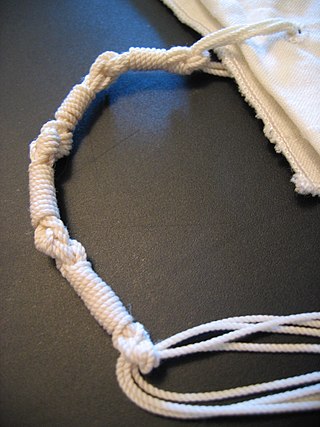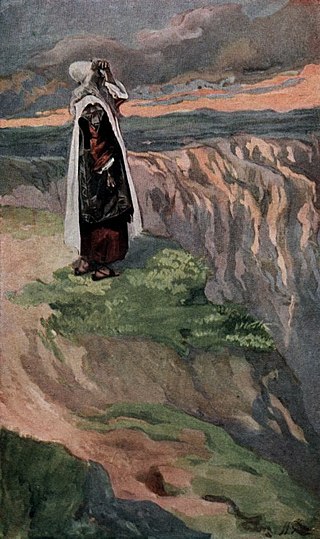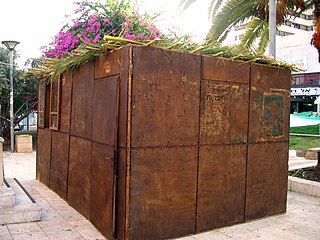
Sukkot is a Torah-commanded holiday celebrated for seven days, beginning on the 15th day of the month of Tishrei. It is one of the Three Pilgrimage Festivals on which those Israelites who could were commanded to make a pilgrimage to the Temple in Jerusalem. In addition to its harvest roots, the holiday also holds spiritual importance with regard to its abandonment of materialism to focus on nationhood, spirituality, and hospitality, this principle underlying the construction of a temporary, almost nomadic, structure of a sukkah.
Shemini Atzeret is a Jewish holiday. It is celebrated on the 22nd day of the Hebrew month of Tishrei in the Land of Israel, and on the 22nd and 23rd outside the Land, usually coinciding with late September or early October. It directly follows the Jewish festival of Sukkot which is celebrated for seven days, and thus Shemini Atzeret is literally the eighth day. It is a separate—yet connected—holy day devoted to the spiritual aspects of the festival of Sukkot. Part of its duality as a holy day is that it is simultaneously considered to be both connected to Sukkot and also a separate festival in its own right.
In its primary meaning, the Hebrew word mitzvah refers to a commandment commanded by God to be performed as a religious duty. Jewish law in large part consists of discussion of these commandments. According to religious tradition, there are 613 such commandments.

Etrog is the yellow citron or Citrus medica used by Jews during the week-long holiday of Sukkot as one of the four species. Together with the lulav, hadass, and aravah, the etrog is taken in hand and held or waved during specific portions of the holiday prayers. Special care is often given to selecting an etrog for the performance of the Sukkot holiday rituals.
Moed is the second Order of the Mishnah, the first written recording of the Oral Torah of the Jewish people. Of the six orders of the Mishna, Moed is the third shortest. The order of Moed consists of 12 tractates:
- Shabbat: or Shabbath ("Sabbath") deals with the 39 prohibitions of "work" on the Shabbat. 24 chapters.
- Eruvin: (ערובין) ("Mixtures") deals with the Eruv or Sabbath-bound - a category of constructions/delineations that alter the domains of the Sabbath for carrying and travel. 10 chapters.
- Pesahim: (פסחים) deals with the prescriptions regarding the Passover and the paschal sacrifice. 10 chapters.
- Shekalim: (שקלים) ("Shekels") deals with the collection of the half-Shekel as well as the expenses and expenditure of the Temple. 8 chapters
- Yoma: (יומא) ; called also "Kippurim" or "Yom ha-Kippurim" ; deals with the prescriptions Yom Kippur, especially the ceremony by the Kohen Gadol. 8 chapters.
- Sukkah: (סוכה) ("Booth"); deals with the festival of Sukkot and the Sukkah itself. Also deals with the Four Species which are waved on Sukkot. 5 chapters.
- Beitza: (ביצה) ("Egg"); deals chiefly with the rules to be observed on Yom Tov. 5 chapters.
- Rosh Hashanah: deals chiefly with the regulation of the calendar by the new moon, and with the services of the festival of Rosh Hashanah. 4 chapters.
- Ta'anit: (תענית) ("Fasting") deals chiefly with the special fast-days in times of drought or other untoward occurrences. 4 chapters
- Megillah: (מגילה) ("Scroll") contains chiefly regulations and prescriptions regarding the reading of the scroll of Esther at Purim, and the reading of other passages from the Torah and Neviim in the synagogue. 4 chapters.
- Mo'ed Katan: deals with Chol HaMoed, the intermediate festival days of Pesach and Sukkot. 3 chapters.
- Hagigah: (חגיגה) deals with the Three Pilgrimage Festivals and the pilgrimage offering that men were supposed to bring in Jerusalem. 3 chapters.
Karaite Judaism or Karaism is a Jewish religious movement characterized by the recognition of the written Tanakh alone as its supreme authority in halakha and theology. Karaites believe that all of the divine commandments which were handed down to Moses by God were recorded in the written Torah without any additional Oral Law or explanation. Unlike mainstream Rabbinic Judaism, which regards the Oral Torah, codified in the Talmud and subsequent works, as authoritative interpretations of the Torah, Karaite Jews do not treat the written collections of the oral tradition in the Midrash or the Talmud as binding.
According to Rabbinic Judaism, the Oral Torah or Oral Law are statutes and legal interpretations that were not recorded in the Five Books of Moses, the Written Torah, and which are regarded by Orthodox Jews as prescriptive and given at the same time. This holistic Jewish code of conduct encompasses a wide swathe of rituals, worship practices, God–man and interpersonal relationships, from dietary laws to Sabbath and festival observance to marital relations, agricultural practices, and civil claims and damages.

Hoshana Rabbah is the seventh day of the Jewish holiday of Sukkot, the 21st day of the month of Tishrei. This day is marked by a special synagogue service, the Hoshana Rabbah, in which seven circuits are made by the worshippers with their lulav and etrog, while the congregation recites Hoshanot. It is customary for the scrolls of the Torah to be removed from the ark during this procession. In a few communities a shofar is sounded after each circuit.

Tzitzit are specially knotted ritual fringes, or tassels, worn in antiquity by Israelites and today by observant Jews and Samaritans. Tzitzit are usually attached to the four corners of the tallit gadol, usually referred to simply as a tallit or tallis; and tallit katan. Through synecdoche, a tallit katan may be referred to as tzitzit.

The four species are four plants - the etrog, lulav, hadass, and aravah - mentioned in the Torah as being relevant to the Jewish holiday of Sukkot. Observant Jews tie together three types of branches and one type of fruit and wave them in a special ceremony each day of the Sukkot holiday, excluding Shabbat. According to Rabbinic Judaism, the waving of the four plants is a mitzvah prescribed by the Torah, and it contains symbolic allusions to a Jew's service of God.

Hadass is a branch of the myrtle tree that forms part of the lulav used on the Jewish holiday of Sukkot.

Aravah is a leafy branch of the willow tree. It is one of the Four Species used in a special waving ceremony during the Jewish holiday of Sukkot. The other species are the lulav, hadass (myrtle), and etrog (citron).

Mishpatim is the eighteenth weekly Torah portion in the annual Jewish cycle of Torah reading and the sixth in the Book of Exodus. The parashah sets out a series of laws, which some scholars call the Covenant Code. It reports the people's acceptance of the covenant with God. The parashah constitutes Exodus 21:1–24:18. The parashah is made up of 5,313 Hebrew letters, 1,462 Hebrew words, 118 verses, and 185 lines in a Torah scroll.

Emor is the 31st weekly Torah portion in the annual Jewish cycle of Torah reading and the eighth in the Book of Leviticus. The parashah describes purity rules for priests, recounts the holy days, describes the preparations for the lights and bread in the sanctuary, and tells the story of a blasphemer and his punishment. The parashah constitutes Leviticus 21:1–24:23. It has the most verses of any of the weekly Torah portions in the Book of Leviticus, and is made up of 6,106 Hebrew letters, 1,614 Hebrew words, 124 verses and 215 lines in a Torah Scroll.

Pinechas, Pinchas, Pinhas, or Pin'has is the 41st weekly Torah portion in the annual Jewish cycle of Torah reading and the eighth in the Book of Numbers. It tells of Phinehas's killing of a couple, ending a plague, and of the daughters of Zelophehad's successful plea for land rights. It constitutes Numbers 25:10–30:1. The parashah is made up of 7,853 Hebrew letters, 1,887 Hebrew words, 168 verses, and 280 lines in a Torah scroll.

Re'eh, Reeh, R'eih, or Ree is the 47th weekly Torah portion in the annual Jewish cycle of Torah reading and the fourth in the Book of Deuteronomy. It comprises Deuteronomy 11:26–16:17. In the parashah, Moses set before the Israelites the choice between blessings and curses. Moses instructed the Israelites in laws that they were to observe, including the law of a single centralized place of worship. Moses warned against following other gods and their prophets and set forth the laws of kashrut, tithes, the Sabbatical year, the Hebrew slave, firstborn animals, and the Three Pilgrim Festivals.

Sukkah is a tractate of the Mishnah and Talmud. Its laws are discussed as well in the Tosefta and both the Babylonian Talmud and Jerusalem Talmud. In most editions it is the sixth volume of twelve in the Order of Moed. Sukkah deals primarily with laws relating to the Jewish holiday of Sukkot. It has five chapters.
Various numbers play a significant role in Jewish texts or practice. Some such numbers were used as mnemonics to help remember concepts, while other numbers were considered to have intrinsic significance or allusive meaning.

Jewish ceremonial art, also known as Judaica, refers to an array of objects used by Jews for ritual purposes. Because enhancing a mitzvah by performing it with an especially beautiful object is considered a praiseworthy way of honoring God's commandments, Judaism has a long tradition of commissioning ritual objects from craftsmen and artists.
There is no chronological order in the Torah is an expression used by many Bible commentators when they encounter events which are out of chronological order. In rabbinic analysis, the issue of chronological order is related to the issue of semichut parshiyot.




















